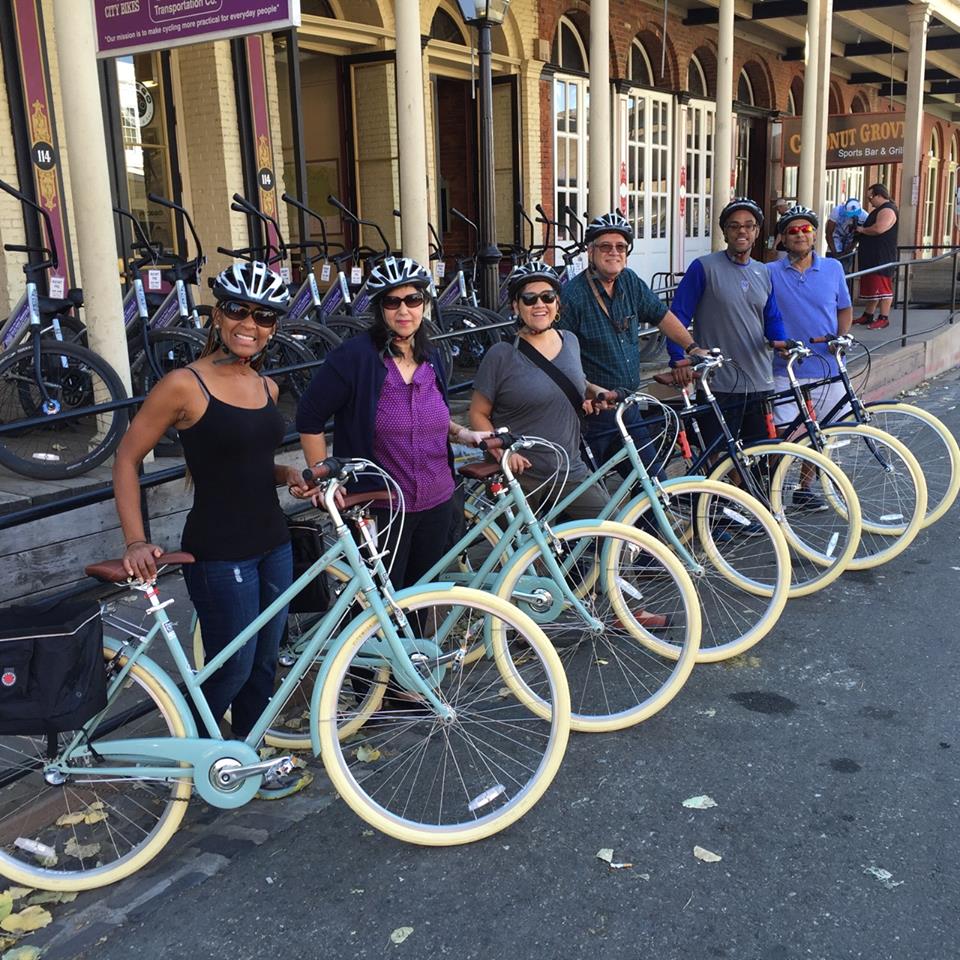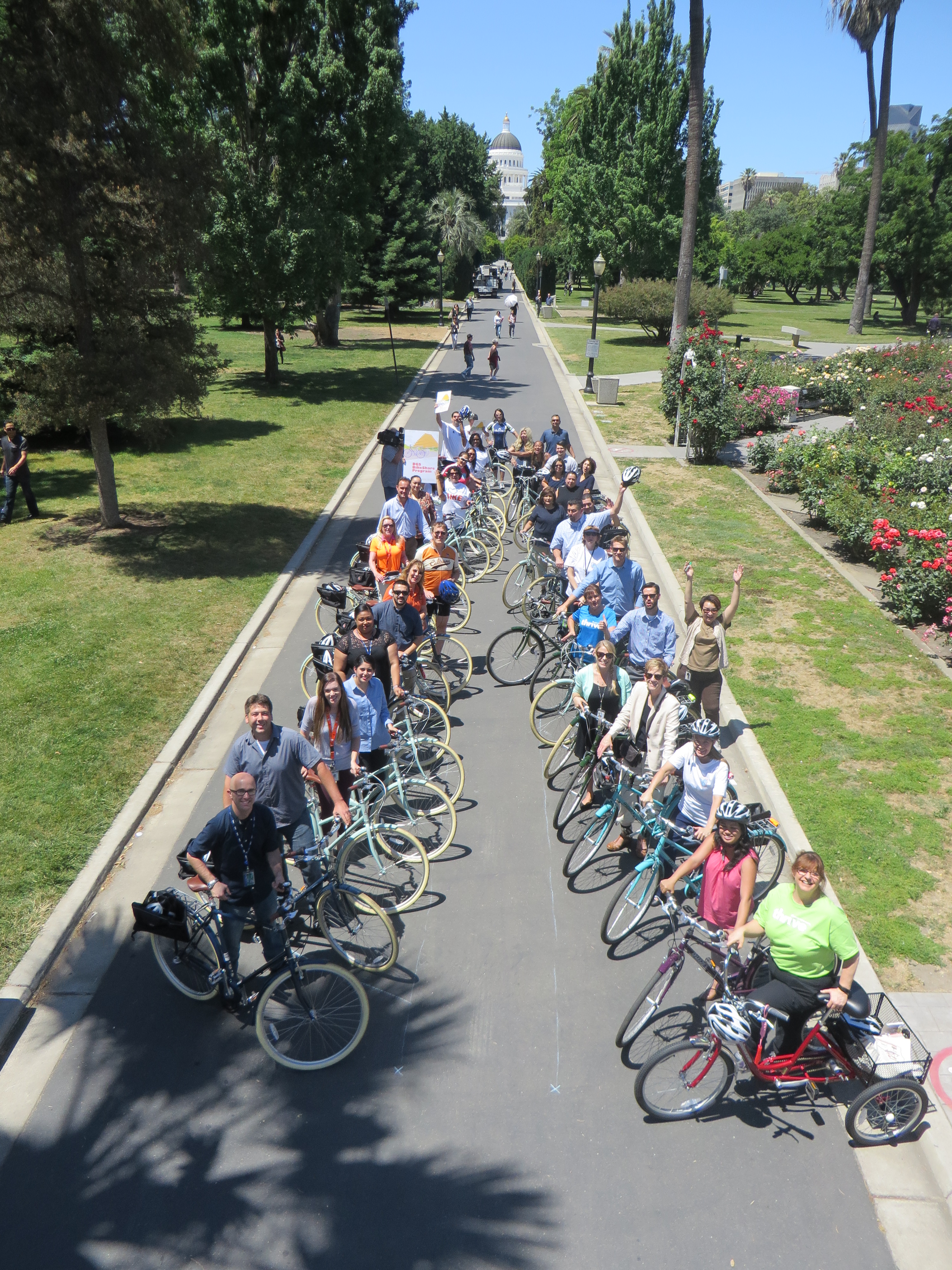DISCOVER YOUR LOCAL BICYCLING COMMUNITY
Find local advocacy groups, bike shops, instructors, clubs, classes and more!
League Cycling Instructor develops Sacramento bikeshare for state employees
This article was originally published in the Fall 2017 edition of Bicycle Friendly America magazine. You can always find the latest issue at bikeleague.org/BFAmag.

In 2007, staff at the California Department of Public Health (CDPH) had a novel idea that has finally become a two-wheeled reality. We were tracking Silicon Valley employers that had begun providing simple bicycles shared between employees to navigate their large campuses. Tech and aerospace giants like Google and Lockheed Martin had these fleets, and we wanted the same thing at our Sacramento campus. As one of the early promoters and now implementers of the concept I remember thinking, “Hey, this makes sense for getting around downtown Sacramento, too, with all of our sister government agencies nearby.”
So what exactly have government employees cooked up in Sacramento that could have implications for other government employees nationwide? Bicycles, free to employees for day use, and ideal for active transport to meetings, personal errands, or just to get some exercise in the middle of the work day. So what’s the big deal and how does this concept differ from the citywide bikeshare programs that are already in and coming to many large U.S. cities?
Sacramento, with its pancake-flat terrain and relatively mild weather is quite amenable to bicycling. Local bike advocates and area planning staff have teamed up to bring more cycling infrastructure each year, including green bike lanes for the city’s grand entrance on Capitol Mall. Scores of residents commute daily on the nearby American River Parkway Trail — 20+ miles of continuous Class I Bikeway connecting the suburbs with the urban core. The city recently earned Silver status in the League’s Bicycle Friendly Community award and is working towards gold. The capital city is also home to dozens of government agencies, and many of those workers must travel between buildings and campuses to attend meetings, get lunch, go to the dentist and just simply get out of the office. So the idea of bikes for employees made sense to me and my colleagues, and in 2007 we asked to draft and pitch a proposal to share with management. But there was just one problem: Where would the money come for the bikes, racks and gear? Unfortunately, state general fund dollars were not available at the time and searching for grants to fund the bicycles was challenging as many of the funders that we contacted were not set up to give money to state government agencies. So, the good idea got shelved.

So what got it going in the end? Two key events started the ball rolling. In fall 2013, a large health maintenance organization began a partnership with the state’s health department to run a three-year worksite wellness pilot program on the very same campus. I never lost sight of this dream to bring bikes to my colleagues; those employees that hadn’t imagined biking in the middle of the day, or didn’t own a bike or hadn’t ridden in decades. So when a chance hallway meeting with the wellness program’s leader came my way, I suggested the bike-sharing idea and volunteered to do the legwork and revise the old proposal. I definitely used the “foot in the door” tactic and suggested that a very small amount of money would be needed to start a pilot program. In retrospect, we could have used a few more dollars but we had enough for the basics and made it work. Second, a colleague at the department (Becky Garrow) won a chance to have lunch with the department Director through a May is Bike Month contest. She was the best possible person to pitch the BikeShare concept to the Director. She is knowledgeable, persuasive and a dedicated bike commuter. Plus, it ended up that he was a cyclist himself so that helped sway his decision to support the concept. With a colleague now helping, a promised bit of seed money from the HMO, and the support of the department’s Director — I had some hope.
That winter, Becky and I met weekly to plan the necessary components (bikes, locks, helmets, panniers, racks, etc.), toured another state agency that had its own fledgling bike fleet, and connected with everyone we could think of in the Department who would have a say in the project. I was meeting with people way above my pay grade and out of my normal professional network including senior management, the legal services office, facilities team, the on-site security captain, the information technology branch, and the list continued. I just kept moving forward and looking for solutions to all the issues that were raised at every meeting. We got a lot of good feedback and had to have even better answers. One requirement from management was offering a safety training for the BikeShare participants. I used my training as League Cycling Instructor (LCI) to modify a one-hour Smart Cycling presentation to meet the needs of the BikeShare program; I’ve delivered the training monthly since the program’s launch.
I credit the League’s LCI program for much of our success.
With perseverance, some luck, supportive colleagues and the political will of the organization’s leader on our side, the pilot project was launched in May 2014 with six bicycles of varying sizes stored securely near CDPH’s parking garage. The CDPH team tracks trips and miles per bike as well as what types of trips are most common. CDPH employees have logged over 3,000 trips since May 2014 and getting some “physical activity” is the most common trip purpose. What has happened since has been nothing short of a major success. To help promote the program, we created two infographics — one for employees and one for employers, a program logo that can be customizable to each participating department and we are set to launch a toolkit this summer for government agencies at any level. The BikeShare Toolkit will include lessons learned, important steps to consider before launching and a slew of helpful sample forms and support materials. Now each year in May, the CDPH team and our colleagues at sister agencies throw a BikeShare Birthday party to celebrate the employees and the bikes they love. The 2017 fest included a cameo by California’s own “Poppy” the State Fair mascot who grabbed the limelight by eagerly hopping on the CDPH adult tricycle (with helmet) to take a spin.
The HMO partner came back at the end of that first year and offered to collaborate again with enough funds to launch five new BikeShare fleets for other government agencies. We pulled together an application for other agencies to use and provided key lessons-learned to aid the new applicants. In the end, five agencies were selected and provided with similar bicycles, locks and racks as the initial CDPH pilot bicycle fleet. Once launched, each new employee BikeShare system took off. The coordinators all meet quarterly to share successes, ride data, promotion and outreach ideas. Another state department even filmed my one-hour safety presentation and uses that to certify new BikeShare users. Last year, the HMO partner offered again to fund more BikeShare systems, and five more agencies were added to the growing bicycle rolls. Today there are 12 state agencies that are participating with a total of 90 bicycles primarily located in Sacramento’s downtown core. Combined, the participating agencies house over 15,000 employees that now have access to a free, healthy, green mode of transportation in the middle of their day. I definitely leaned on the skills gained through being a League Cycling Instructor at key junctures while launching the program. The League’s LCI program carried weight and respect, and I was able to open a lot of doors with that credential. I credit it for much of our success.
Now it is not uncommon to see the hunter green, seafoam and navy blue city bikes being pedaled around downtown Sacramento. I hope that this is just the beginning. Separately, legislation has even been introduced in the California State Senate (SB 702, Stern) this year to institutionalize a similar program at all state-operated buildings. And to quote one CDPH employee: “[this is] worksite wellness at its finest … [I’m] using the bikes for exercise and I love it.” The nicks, scratches and wear on the bikes show how much they are truly used and enjoyed. Hopefully someday, every new state employee will simply just be shown where the bikes are kept — as a sign of California’s culture of wellness.
Jeffery Rosenhall is LCI #2312 and Health Program Manager at the California Department of Public Health.
